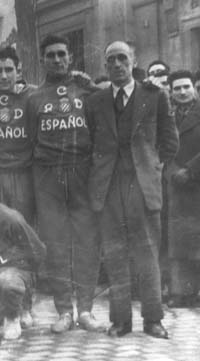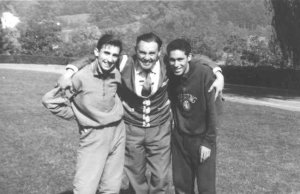PERSONAL TRAINERS
 Manuel Cutié was considered, in his time, the best Spanish trainer for long distance runners. All the best Catalan athletes, who were then the best in Spain too, came under his tutelage: Gregorio Rojo, Constantino Miranda, José Coll, Buenaventura Baldomá, José Molins, Luís García, Antonio Amorós, Jaume Guixà, Domingo López (who, incidentally, was the first athlete to win the Spanish Cross Country Championships in the juvenile category), Miguel Navarro, Francesc Guardia and Josep Quesada among others. All of these athletes made the best possible use of his sage advice. Cutié was the man who rescued Tomás Barris, for Spanish athletics, when he was demoralized by early mediocre results. He stopped Barris abandoning sports altogether and convinced him of his great potential in the middle distance field.
Manuel Cutié was considered, in his time, the best Spanish trainer for long distance runners. All the best Catalan athletes, who were then the best in Spain too, came under his tutelage: Gregorio Rojo, Constantino Miranda, José Coll, Buenaventura Baldomá, José Molins, Luís García, Antonio Amorós, Jaume Guixà, Domingo López (who, incidentally, was the first athlete to win the Spanish Cross Country Championships in the juvenile category), Miguel Navarro, Francesc Guardia and Josep Quesada among others. All of these athletes made the best possible use of his sage advice. Cutié was the man who rescued Tomás Barris, for Spanish athletics, when he was demoralized by early mediocre results. He stopped Barris abandoning sports altogether and convinced him of his great potential in the middle distance field.
Olli Virho, Finnish trainer contracted at the request of Juan Antonio Samaranch by the Barcelona City Council. He introduced the Nordic training  method of the Verömekki school into Spain. This largely consisted of constant races over grass and through woods. Continuous changes of rhythm at a moderate pace, etc. which quickly appealed to athletes due to the apparent ease with which the method could be assimilated. However, despite any apparent ease, the method slowly built up the stamina essential for competitions. Virho was the trainer who put Barris firmly onto the next stage of his career: winning titles, breaking Spanish records and opening up the international scene.
method of the Verömekki school into Spain. This largely consisted of constant races over grass and through woods. Continuous changes of rhythm at a moderate pace, etc. which quickly appealed to athletes due to the apparent ease with which the method could be assimilated. However, despite any apparent ease, the method slowly built up the stamina essential for competitions. Virho was the trainer who put Barris firmly onto the next stage of his career: winning titles, breaking Spanish records and opening up the international scene.
Woldemar Gerschler, together with the famous German cardiologist Reindell, were the discoverers of the Interval Training method (a training by instalments method that revolutionized international athletics preparation).  Many world record breaking athletes and Olympic Champions attended his school in Freiburg including Rudolf Harbig, Gordon Pirie, Josy Barthel, Roger Moens, as well as many more of the best athletes of those times. Winter training in Freiburg was a real cavalry. The training track was an interminable straight track 400 meters long, almost always covered with frozen snow. Divided into 100 meter sections with stakes driven into the ground parallel to and beside the River Breisgau. There was a continuous buzz of activity, in freezing temperatures that usually oscillated around 8 to 10 degrees below zero. Apart from being monotonous, this training was truly tough and based, fundamentally, on a series of 100 and 200 meter sprints. Every day, more of the same. Thanks to Gerschler's tough system, Barris, who knew how to make the most of this hard work schedule, would achieve a leading place among the world's elite.
Many world record breaking athletes and Olympic Champions attended his school in Freiburg including Rudolf Harbig, Gordon Pirie, Josy Barthel, Roger Moens, as well as many more of the best athletes of those times. Winter training in Freiburg was a real cavalry. The training track was an interminable straight track 400 meters long, almost always covered with frozen snow. Divided into 100 meter sections with stakes driven into the ground parallel to and beside the River Breisgau. There was a continuous buzz of activity, in freezing temperatures that usually oscillated around 8 to 10 degrees below zero. Apart from being monotonous, this training was truly tough and based, fundamentally, on a series of 100 and 200 meter sprints. Every day, more of the same. Thanks to Gerschler's tough system, Barris, who knew how to make the most of this hard work schedule, would achieve a leading place among the world's elite.



